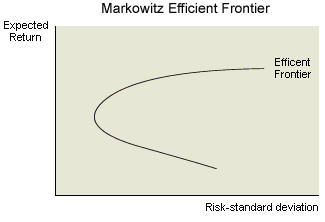CFA Level 1 - Portfolio Management
The Efficient Frontier
Markowitz' work on an individual's investment behavior is important not only when looking at individual investment, but also in the context of a portfolio. The risk of a portfolio takes into account each investment's risk and return as well as the investment's correlation with the other investments in the portfolio.
| Look Out! Risk of a portfolio is affected by the risk of each investment in the portfolio relative to its return, as well as each investment's correlation with the other investments in the portfolio. |
A portfolio is considered efficient if it gives the investor a higher expected return with the same or lower level of risk as compared to another investment. The efficient frontieris simply a plot of those efficient portfolios, as illustrated below.
Figure 17.2: Efficient Frontier

While an efficient frontier illustrates each of the efficient portfolios relative to risk and return levels, each of the efficient portfolios may not be appropriate for every investor. Recall that when creating an investment policy, return and risk were the key objectives. An investor's risk profile is illustrated with indifference curves. The optimal portfolio, then, is the point on the efficient frontier that is tangential to the investor's highest indifference curve. See our article: A Guide to Portfolio Construction, for some essential steps when taking a systematic approach to constructing a portfolio.
| Look Out! The optimal portfolio for a risk-averse investor will not be as risky as the optimal portfolio of an investor who is willing to accept more risk. |






0 comments:
Post a Comment